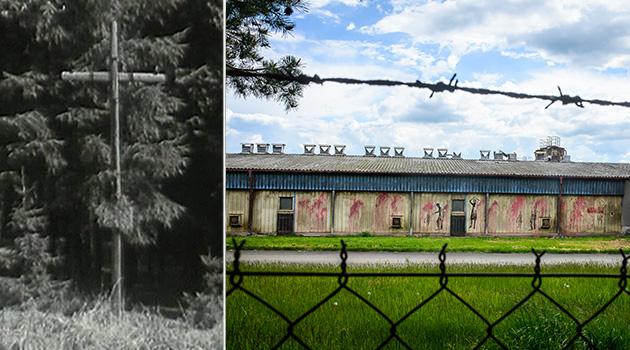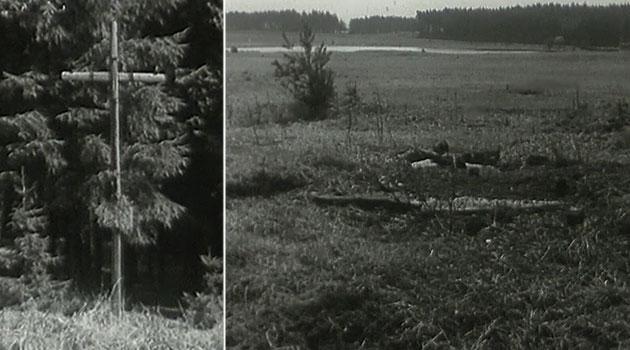Lety after the Romani genocide, Part Two: Survivors erect a cross, protests against pig farm ignored

This is the second part in our series dedicated to the postwar history of the former “Gypsy Camp” at Lety u Písku, or rather, the history of its locations and surroundings as influenced by the overall developments of the history of Romani people on Czechoslovak territory, developments involving the apparatus of the state, attempts by Government officials and representatives to “solve the Gypsy question”, and a Romani intelligentsia striving for democratic dialogue and self-determination. Beginning in the 1950s, when Communist Party rule became stabilized, the country was able to concentrate more on the so-called “gypsy issue”, which required addressing.
Of the indigenous Czech Roma, only several hundred returned to Bohemia and Moravia after the war, but large waves of Romani people from Slovakia arrived in those regions at that same time. Among the new arrivals, some intended to settle and begin a better life for themselves, while others were those whose livelihoods were earned by traveling door-to-door (e.g., blade grinders).
Neither the Romani activists nor the selected authorities who were systematically trained to “re-educate the inadaptables” managed to fulfill their roles in such a way that the integration of Romani people with the majority society could happen according to plan – and as fast as possible. There were so many factors involved that did not accord with the idea of how a “citizen of a socialist state” should behave that decisions ended up being taken which would later prove to be of fundamental importance.
Those decisions were taken despite calls from expert rejecting the idea of assimilation as an instrument for addressing “the Romani issue”, calls emphasizing the need to cultivate the Romanes language and to define the ethnic classification of Romani people and their status in society (see, e.g., the Scientific Council at the Institute for Oriental Studies at the Czechoslovak Academy of Sciences). As a move meant to give Romani people a status equal to that of the majority society, Act No. 117/1927, “on wandering Gypsies” (which had served, among other things, as the basis for the “inventory” that was later compiled of Romani people and used for their subsequent deportations to Auschwitz and elsewhere) was abolished, influencing the fates of Romani people after the war.
Of course, Romani people decidedly never enjoyed any improvement to their status in practice. The most basic turning point to impact Czechoslovak Romani people’s lives happened in 1958.
In October of that year Act No. 74/1958 was published, about the “permanent settlement of traveling persons”. The law did not just affect those who actually lived itinerantly, but also those who were, for example, permanently registered with a municipality but had no permanent employment.
Imprecise definitions of these concepts led to arbitrary interpretations of them by bureaucrats and to unpleasant consequences. During this period the Romani intelligentsia attempted, in vain, to engage in a dialogue with the Government as equal partners in order to get permission to establish their own organizations to support the emancipation of the Romani people.
Building from the “Gypsy Camp” used in the town
As was mentioned in Part One, in 1959 a short documentary film, “Don’t Forget About That Little Girl” (Nezapomeňte na tohle děvčátko) was produced by director Miroslav Bárta. The film tells the story of the tragic fate of the children imprisoned in the camp at Lety who were then transported to Auschwitz.
The film was shown at several international festivals and ran for an entire year in cinemas in Prague before feature films. In 1961 a review of it was even published in the Literary noviny cultural review.
At the end of the 1960s and start of the 1970s what is most associated with the Romani victims of genocide is the wave of applications for certification under Act No. 255/1946 for the compensation being given to those who fell into the category of Czechoslovak political prisoner. Even though such an opportunity had existed since 1946, many of the Romani former prisoners in the so-called “Gypsy Camps” at Hodonín u Kunštátu or Lety, including those who had later been transported to Auschwitz, had only learned about it in a random fashion.
A significant role in disseminating this information was played by the Union of Gypsies-Roma (Svaz Cikánů-Romů – 1969-1973), especially in aiding survivors with applying (a process lasting several years). In the meantime, the location of the so-called “Gypsy Camp” at Lety, demolished in 1943, was being further “cleaned up”.
Some eyewitnesses to this history say that one of the “buildings” that once stood in the Lety camp was later moved into the municipality itself, onto a private plot of land (personal testimony recorded December 2018 in Lety) and most probably served as a warehouse for farm equipment. After the war, apparently because of the typhus epidemic that had broken out at the former camp, the municipality pledged not to build anything on that location for the next 40 years.
The mystery of the cross
We have just bits and pieces of information about the fact that after the war, the bereaved and the survivors of Lety regularly visited the location of the camp where their relatives’ lives had been lost and continued to do so for 20 years – one indicator of this is the above-mentioned film from 1959, which features a shot of a cross with a crown of thorns on it at Lety. The local chronicler, Mr Čanda, took note of this memory of his own in 1992: “My father-in-law told me that sometime during the 1960s somebody came to the local pub whose relatives had died in the camp. From the local wheelwright, Er. Šlapák (who is no longer alive), this person ordered and paid for a wooden cross with a crown of thorns made of wire for Lipěž [forest]. Of course, I cannot find any mention of that in the chronicle.”
Since the film was made at the end of the 1950s, we might assume that this respondent (and the person facilitating his testimony) did not date this event and the subsequent erection of the cross exactly, but it does shed more light on explaining where the cross came from – and the chronicle itself reveals one more record about commemorative ceremonies in the area prior to the industrial pig farm being built on the site of the former camp. In the year 1968, a private commemoration of the Romani victims of the camp took place at the cemetery in Mirovice, an event which we might associate with the relaxation of the political atmosphere and the beginning of the democratizing process, during which the creation of the Union of Gypsies-Roma acquired a very clear definition.
Industrial pig farm
Despite this, the building of an industrial pig farm at Lety begins to be discussed during the 1970s, or rather, the search for an appropriate location for the construction of a large feed lot for pigs with modern technology and the corresponding air conditioning requirements. The locality of the municipality of Lety-Bobina was technically appropriate for this in many respects.
An eyewitness to those discussions with the local assembly recalls that he was one of a very few people to protest building the farm at this remembrance site (personal testimony December 2018). In the local chronicle for the year 1974 it is noted that “A gigantic pig feed lot was built, a “piggery”. There were 10 feed halls constructed, each for 1 000 pigs, and it was completed by the end of November 1974.”
Those who commissioned this building and constructed it, and naturally the local residents, were all informed about the existence of the former camp at that location, and not infrequently those involved had themselves been eyewitnesses to its wartime existence. One local resident recalled that her grandfather had aided with the building of the camp structures and had then worked near it.
According to this resident, her grandfather was fired after he stood up for an imprisoned child who was being beaten by a gendarme for his “unauthorized movements along the fence”. The local chronicle also notes, immediately after the record on the building of the industrial pig farm in 1974, what life had been like in the so-called “Gypsy Camp” there, a description running to four pages.
At that time the only place of reverence, of course, was considered to be the former burial ground for the camp victims in the nearby grove of trees, where those who died of typhus are said to have been interred. As one of the respondents who has provided testimony to researchers has stated (see Pařízková 2007), once the industrial pig farm buildings were erected just a couple of hundred meters away from those mass graves, nobody visited the site to commemorate the victims anymore.
Sources:
Nečas, Ctibor. Holocaust českých Romů. Prostor. 1999
Nečas, Ctibor. Historický kalendář. Univerzita Palackého. Olomouc. 1997
Pařízková, Jindra. Památka obětem romského holocaustu- Internační tábor Lety u Písku a jeho poválečná historie. Univerzita Karlova. 2007
Pavelčíková, Nina. Romové v českých zemích v letech 1945-1989.
Úřad dokumentace a vyšetřování zločinů komunismu. 2004
Sadílková, Helena. Slačka, Dušan. Závodská, Milada. Aby bylo s námi počítáno. Muzeum romské kultury. Brno. 2018
Slačka, Dušan. „Cikánská otázka“ na Hodonínsku v letech 1945–1973. Magisterská diplomová práce. Masarykova univerzita v Brně. 2015
Kolektiv autorů. Romové v České republice (1945-1998). Socioklub. Praha. 1999
Kronika obce Lety
Personal testimonies of two local residents of Lety, interviews conducted December 2018.
